Dundas County Militia
The Dundas County Militia was a regiment of the provincial militia of Upper Canada that was raised in Dundas County, Ontario, in the 1780s.[1] The battle honours and legacy of the Dundas Militia are perpetuated by the Stormont, Dundas and Glengarry Highlanders.
| Dundas County Militia | |
|---|---|
 Dundas Militiaman on the left, 1813 | |
| Active | 1788 – 1869 |
| Country | Upper Canada |
| Allegiance | United Kingdom of Great Britain and Ireland |
| Branch | Canadian Militia |
| Type | Militia |
| Size | Regiment |
| Anniversaries | November 11th (Crysler's Farm) |
| Engagements | Spanish Armament of 1793 |
| Commanders | |
| Notable commanders | Richard Duncan Allan MacDonell Thomas Fraser John Crysler |
United Empire Loyalists and Establishment
The military history of Dundas County dates back to the early settlement days, when Loyalist veterans of the American Revolution were granted plots of land in Upper Canada and raised a local militia. The first Loyalist settlers landed in Dundas on the banks of the St Lawrence River in June 1784 and almost immediately raised a local militia force. Many of the families were German Palatines who had remained loyal to Great Britain and fought during the war with the King's Royal Regiment of New York, Butler's Rangers, and Loyal Rangers.
The oldest commission found for what would become the Dundas Militia is from June 20, 1788, when Jacob Farrand (Farran) was issued a commission as a Captain by Lord Dorchester in the Williamsburg and Matilda Battalion of Militia.[1] In 1792, Dundas County was formally established by a proclamation of the lieutenant governor of Upper Canada, John Graves Simcoe, and by his orders each county would have a Lieutenant to fulfill the position of magistrate and militia commander, Richard Duncan serving as the first lieutenant and colonel of the Dundas Militia in 1793.[2]

The Spanish Armament of 1793 caused fear throughout the British colonies, and many militias were raised in the Canadas in case of the outbreak of war. Colonel Duncan commanded the Dundas Militia and many men joined the part-time force. War was averted, however, and the militias were not used in any military capacity, but it showed the importance of the volunteer militias to the defence of Upper Canada.
By 1803, the regiment had grown in size, and a report from that year lists the following officers:
- Lt-Col. Allan McDonell
- Maj. Malcolm McMartin
- Capts. Michael Hanes, Farquhar McDonell, Cornelius Munro, Allan Patterson
- Lts. Jacob Merkley, Henry Merkley, Michael Ault, Jacob Weager, Jesse Wright, John Serviss.
- Ens. John Shaver, John Munro, Frederick Weaver, Jacob Van Allen, Michael Carman
- Adj. Jacob Weaver
- Q.M. Alexander McDonell
The 1808 report gives the following statistics of the regiment: 1 Lt-Colonel, 1 Major, 4 Captains, 5 Lieutenants, 6 Ensigns, 1 Adjutant, 1 Quartermaster, 1 Surgeon, 14 Sergeants and 238 rank and file.[3]
War of 1812
When the War of 1812 broke out in June 1812, the Dundas Militiamen gathered to prevent an invasion of their homeland. The men mustered into two flank companies at Mariatown on July 11, 1812, and the companies were formed into the 1st Regiment of Dundas Militia. This regiment fought throughout the war, with many men from the regiment being transferred to the Incorporated Battalion of Canadian Militia fighting in the Niagara campaign and at the Battle of Lundy's Lane.
The principle engagements of the 1st Regiment of Dundas Militia were:
Battle of Matilda – On September 16, 1812, soldiers from the 1st Dundas Militia under Capt. Michael Ault and Ens. Duncan Clark, as well as the Royal Newfoundland Regiment, were escorting a shipment of supplies from Montreal to Kingston when they were attacked near Matilda by 500 American Militia who were hiding on Toussaint Island. The Dundas militia landed on Presqu'ile Island just as an American force landed on the same and an exchange of fire occurred. The Americans were driven back and retreated to Toussaint's Island, and soon more Dundas men arrived on Presqu'ile in case of a second invasion. Col. MacDonell in command of the Dundas Militia, along with Capt. Shaver and Capt. Ault were joined by Grenville Militia and a 9-pounder artillery piece from Prescott that had originally been captured during the Battle of the Thousand Islands. After a few rounds of fire from the cannon and muskets, the Americans abandoned the island and retreated across the border. Canadian losses were one killed and several wounded.[3]
First Battle of Ogdensburg – The Dundas Militia next fought at the First Battle of Ogdensburg on October 4, 1812, launching an amphibious raid from Prescott to gather supplies but being turned back by American artillery and militia.
Battle of French Mills – New York State Militia captured the British post at Akwesasne, an Indian community that straddled the St. Lawrence River in a location where the present-day borders of Ontario, Quebec and New York State intersect. It, and the nearby American post at French Mills on the Salmon River, were recaptured on November 23, 1812, by a British Canadian force, including the Dundas Militia, carrying supplies up the St. Lawrence River.[3]
In early 1813, Thomas Fraser took command of the Dundas Militia from Col. Macdonell, who retired due to old age, having first seen battle at Culloden. Fraser served as Colonel until late 1813.[4]
Second Battle of Ogdensburg – On February 22, 1813, a British Canadian force including the 1st Regiment of Dundas Militia, crossed the frozen St Lawrence River and charged the American fort at Ogdensburg. The Americans fought back but were eventually forced to retreat and the British and Canadians captured the town, burning the boats and taking the artillery and military supplies back to Prescott.
On November 5th, as Wilkinson's American army moved down the St. Lawrence River towards Cornwall, Lieutenant Duncan Clark of the Incorporated Militia, formerly an Ensign in Capt. Ault's Flank Company of the 1st Dundas Regiment, was on duty on the shoreline and under orders to raise the alarm upon any American movements. Seeing the mass of boats moving down the river, Lieutenant Clark commandeered a sturdy plough horse from a nearby farm and rode the length of the front from Elizabethtown to Prescott alerting the local militia and civilians with the cry "The enemy is at hand!". His ride along the front was likened to the ride of Paul Revere in 1775, and Duncan Clark has since been heralded as the "Canadian Paul Revere".
Battle of Iroquois Point - American forces under General James Wilkinson crossed the St Lawrence River and hoped to march on Montreal, but the local British and Canadian forces engaged them before they could move past Dundas County. On November 7, a piquet of Dundas Militia at Point Iroquois discovered the American forces moving up the St Lawrence, and Ptes. Peter and John Brouse, brothers of George Brouse, were the first to fire upon the enemy. As more Dundas Militiamen were brought up to the point, 1,200 American soldiers under Alexander Macomb, Winfield Scott, and Benjamin Forsyth landed on the shore and began to engage the outnumbered militia. After a sharp firefight, the 200 men from the 1st Dundas Regiment were forced to retire inland, but the delaying action gave precious time to the forces in Cornwall and Morrisburg.
Skirmish at Doran's Farm - With the advance of Wilkinson's Army towards Montreal in November 1813, a line of supply boats under military escort set out from Montreal to ascend the St. Lawrence River and bring much needed supplies to the British forces at Prescott. An American force posted on Ogden's Island noticed the approaching convoy and decided to capture the supplies. Suspecting danger, the British force brought their boats to a halt and the supplies destined for Prescott were landed in Dundas County where the services of the farmers in the vicinity were secured and before midnight the stores were all placed in wagons, by which manner they were to be taken to Prescott, while the boats were to return to Cornwall. Suddenly a messenger arrived and reported the presence of 500 American dragoons. The loaded wagons were removed some distance from the river where they delayed for a time before proceeding to Prescott. Instructions were given to those in charge of the boats to drop down the river as far as Hoople's Creek, while the handful of Glengarry and Dundas Militia, already worn out with fatigue, started eastward to meet the foe. The force of Glengarry and Dundas Militiamen sighted the advancing American forces at the Doran family farm near Iroquois and at once concealed themselves in the wood lines. As the Americans drew near, a well directed fire from the Militia killed 11 and wounded several. The Americans fled to their boats and recrossed to the other side of the river, while the militia marched to Hoople's Creek, joined the flotilla awaiting them, and proceeded to Cornwall in preparation of the main American attack.
As the American forces pushed east through Williamsburg township, Trooper John W. Loucks of Fraser's Provincial Light Dragoons, formerly of the 1st Dundas Regiment, was on duty at the bridge over Nash Creek. When the advance parties of the American army came into view, Trooper Loucks set fire to the Nash Creek Bridge in order to prevent their advance. He then rode east to alert the Dundas Milita before riding north and west around the American force to contact the British forces coming from Kingston.

Battle of Crysler's Farm – On November 10, a force of Glengarry and Stormont Militia engaged the Americans at the Battle of Hoople's Creek and on November 11, they, along with the Dundas Militia, Leeds Militia, Canadian Fencibles, the 49th Regiment of Foot and the 89th Regiment of Foot, engaged the main American force at John Crysler's farm in Williamsburg township. Capt. John Crysler was now in command of the Dundas Militia and, with Major Henry Merkley, led the regiment bravely at the battle, where they served as stretcher bearers, skirmishers, and helped supply ammunition.
Salmon River Raid – In February 1814, the American forces near French Mills began leaving their supply depots and garrisons for Plattsburgh and Sackett's Harbor. On the 19th, a British Canadian force including the Dundas Militia crossed to the Salmon River, setting fire to the abandoned boats and barracks of the Americans, capturing considerable amounts of ammunition and supplies to bring back to Dundas.[3]
From September 1812 until the end of the war, the 1st Dundas Regiment was engaged in building and garrisoning earthworks and blockhouses along the St. Lawrence River. One such earthwork was located at Point Iroquois. The initial earthwork was reconstructed as a blockhouse in 1814 was named Fort Needless due to its inactivity so late in the war.
In mid-1813, two volunteer cavalry troops were raised in Dundas and filled with men from the Dundas Militia. Captain Fraser's Troop of Provincial Light Dragoons and Captain Adam's Troop of Provincial Light Dragoons both fought alongside the Dundas Militia at Crysler's Farm.
| Soldier | Casualty | Action |
|---|---|---|
| Unnamed Private | Killed in action | Matilda (Sept. 16, 1812) |
| Unnamed Private | Wounded in action | Matilda (Sept. 16, 1812) |
| Capt. John Macdonell | Wounded in action | Ogdensburg (Feb. 22, 1813) |
| Pte. James Stamp | Wounded in action | Ogdensburg (Feb. 22, 1813) |
| Pte. Peter Onderark (Ouderkirk) | Killed in action | Ogdensburg (Feb. 22, 1813) |
| Capt. Jesse Wright | Died of disease | Fort Wellington (Mar. 1, 1813) |
| Ens. William Welsh | Died of disease | (1813) |
| Pte. John McKay | Accidentally wounded, loss of eye | Fort Wellington (October 22, 1814) |
Medals
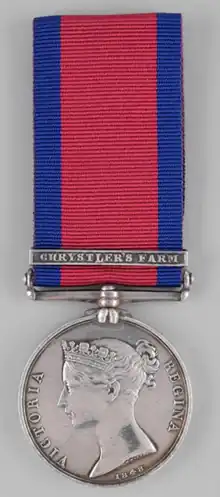
In 1848, the Military General Service Medal was created with a clasp for Crysler's Farm and the following men were awarded the medal for service with the Dundas Militia:[5]
- Capt. John Crysler
- Sgts. Peter Brouse, John Cook, John Loucks
- Ptes. Nicholas L. Ault, Peter Baker, Jacob Brouse, George Cook, John Doran, Frederick Laut, Peter Loucks, Angus McKay, John Pillar, Robert Redman, Conrad Kintner, Joseph Langevin, John Strader, Edward Shaver, Robert Thompson
Rebellions of 1837–1838
On January 21, 1822, the Dundas Cavalry Troop was formed under Capt. Peter Shaver, Michael Brouse and George Ault commissioned Lieutenants, Jacob Brouse commissioned Cornet. The cavalry troop was attached to the Dundas Militia regiments into the 1840s, and served duty during the Rebellion in 1838.[6]
In 1837, the 1st Regiment of Dundas Militia was reorganized into two battalions, or regiments, to better serve the new townships of Winchester and Mountain. The 1st Regiment (Battalion) would serve Winchester and Williamsburg and was commanded by Col. John Crysler and Lt. Col. J. MacDonell. The 2nd Regiment (Battalion) would serve Mountain and Matilda and was commanded by Col. George Merkley and Lt. Col. MacDonell.[1]
With the outbreak of the Rebellions of 1837–1838 the two regiments of Dundas Militia were again called out for the defence of the county. On November 12, 1838, men of the Hunters' Lodges came ashore in Prescott and took refuge in the windmill there, and a force of British Regulars along with the Grenville Militia, Glengarry Highlanders, Incorporated Militia, and Dundas Militia were dispatched to drive them back across the St Lawrence River. At the Battle of the Windmill, a force of 300 men from the 1st Dundas Regiment, commanded by Col. John Crysler, and the 2nd Dundas Regiment, commanded by Col. George Merkley, participated in the main attack on November 13 and were present for the surrender on November 16.[1] Casualties from the Dundas Militia were three killed and eight wounded.
| Soldier | Company and Regiment | Casualty |
|---|---|---|
| Pte. Jeremiah Bouck | Capt. Doran's Company 2nd Dundas Regiment | Killed in action |
| Pte. J. McMartin | 2nd Dundas Regiment | Killed in action |
| Pte. Richard Boulton | 2nd Dundas Regiment | Died of wounds |
| Lt. John Parlow (great-grandfather of Kathleen and Maida Parlow) | Capt. Doran's Company 2nd Dundas Regiment | Severely wounded in action |
| Sgt. John A. Shaver | Capt. Crysler's Company 1st Dundas Regiment | Wounded in action |
| Pte. William Errington | Capt. Crysler's Company 1st Dundas Regiment | Wounded in action |
| Pte. John Devline | Capt. Doran's Company 2nd Dundas Regiment | Wounded in action |
| Pte. Francis Fye | 2nd Dundas Regiment | Wounded in action |
| Pte. William Myers | Capt. Doran's Company 2nd Dundas Regiment | Wounded in action |
| Pte. James Connovers | 2nd Dundas Regiment | Wounded in action |
| Pte. William Lennox | Capt. Shaver's Company 2nd Dundas Regiment | Wounded in action |

Following the Battle of the Windmill, the 1st and 2nd Regiments (Battalions) of Dundas Militia were presented with a set of colours, emblazoned with the emblem of a windmill in recognition of their heroic actions at the battle. Col. John Crysler applied to Lt-Gen. Sir John Colborne for the authority for the regiments to carry this device on their colours.[8] When the Crysler's Farm Monument was unveiled on September 25, 1895, the Morrisburg High School Cadets carried a flag that had been borne by the 2nd Dundas Regiment (Battalion) at the Battle of the Windmill. It was also around this time that the Dundas militia was referred to as the 'Royal Dundas Regiment' as evidenced by the inscription on the flag of the 2nd Dundas Regiment.
Reorganization of the Militia
In 1842, the Dundas Militia was reorganized, being split into three battalions. The 1st Battalion would serve Williamsburg Township, the 2nd Battalion would serve Matilda Township, and the 3rd Battalion would serve Winchester and Mountain Townships.[3] These battalions would form part of the larger "Regiment of the Eastern District", a united regiment composed of battalions from Stormont, Dundas, and Glengarry to serve all three counties.
The Militia lists for 1851 record the following officers of the Dundas Militia with their dates of commission:
1st Battalion (Williamsburg): [9]
Lt Col. John Crysler - Nov. 5, 1846
Majors Cephranus Casselman - Jan. 13, 1847, John P. Crysler - Aug. 16, 1850
Captains John Hickey, George Cook, William Kyle, Isaac N. Rose, Adam Nudle, George Weaver, Henry Weagear, William Swayne - Jan. 13, 1847, Conrad Casselman - Dec. 19, 1850
Lieutenants Josiah Southworth, Peter J. Loucks, John W. Loucks, Alex. Colquhoun, Walter Bell, John Marsellis, Cornelius Nevins - Jan. 13, 1847, Samuel J. Crysler, Pembroke G. Crysler - Oct. 7th, 1847, Jacob Merkley - Dec. 19, 1850
Ensigns Michael Pellar, John Brouse, William Weaver, John Munro - Jan. 13, 1847, Samuel Weagant, Michael Hickey, Seph. M. Casselman, William Dicks, Guy J. Loucks - Oct. 7, 1847, John R. Crysler - Dec. 19, 1850
Adjutant James Baker - Oct. 7, 1847
Quarter Master Jacob Hanes - Jan. 13, 1847
Surgeon John Grant - Jan, 13, 1847
2nd Battalion (Matilda):[9]
Lt Col. David Robertson - Dec. 9, 1846
Major George Ault - Mar. 31, 1847
Captains John Savor, George Brouse, Sydney Doren, James West, Samuel Shaver, John Strader, Simeon Ault - Mar. 31, 1847, John Parlow - Sep. 25, 1850
Lieutenants David Coons, George Carman, Alonzo C. H. Shaver, James Doren, Nicholas N. Brouse, Isaac Keeler, Alex. Macdonell, Henry Van Allen - Mar. 31, 1847, Matthew Coons - Sep. 25, 1850
Ensigns Nicholas Carman, George J. Brouse, Henry Merkley, John Flagg, Alonzo B. Robertson, James N. Nettleton, John Servis, James Glasford - Mar. 31, 1847, David Mcintosh - Aug. 2, 1847
Adjutant Nicholas N. Brouse - Mar. 31, 1847
Quarter Master George Robertson - Aug. 2, 1847
3rd Battalion (Winchester and Mountain):[9]
Lt Col. Peter Shaver - Nov. 5, 1846
Major Jacob Brouse - Mar. 24, 1847
Captains William S. Shaver, Robert Grey, John Dillabough, James A. Liddle, John Van Camp, Edward Brouse, George T. Shaver - Mar. 24, 1847, Elijah Van Camp, Andrew Summers, Peter Smith - May 12, 1847
Lieutenants William Shaver Jr., Henry H. Boulton - Mar. 24, 1847, Marcus (Mark) Redmond, Robert O. Mullen, Joseph Hindman, James Slater, Thomas Armstrong, George Fitchell, Charles Parker, Alex. H. Monro, Reuben Shaver - May 12, 1847
Ensigns John Armstrong, John White, Hezekiah Clark, Edward Price, Andrew Sipes, George Dillabough, Samuel Bigford, David Farrell, Giles W. Bogart, John McCargar - May 12, 1847
Adjutant Edward Brouse - Mar. 24, 1847
Quarter Master William Laing - May 12, 1847
In 1852, the "Regiment of the Eastern District" was disbanded and returned to individual county regiments, with the 3rd Battalion, Dundas Militia being split into two battalions; the '3rd Battalion' serving Mountain Township, and the new '4th Battalion' serving Winchester Township. The first two battalions remained the same.[3]
With the passage of the Militia Act of 1855, the counties of Leeds, Dundas, Stormont and Glengarry became part of Military District No. 2.
The militia report for 1858 lists the following officers and their dates of commission:
- 1st Battalion (Williamsburg) – Commanded by Lt-Col. Alexander Macdonell – March 19, 1852 [10]
- 2nd Battalion (Matilda) – Commanded by Lt-Col. David Robertson – December 9, 1846[10]
- 3rd Battalion (Mountain) – Commanded by Lt-Col. Edward Brouse – April 3, 1856 [10]
- 4th Battalion (Winchester) – Commanded by Lt-Col. Jacob Brouse – May 13, 1853 [10]
The militia report for 1859 lists the following strength of the Dundas Militia:
- 1st Battalion (Williamsburg) – Commanded by Lt-Col. A.G. Macdonell, with 726 men fit for service and 187 in reserve, a total of 913 for the township.[3]
- 2nd Battalion (Matilda) – Commanded by Lt-Col. David Robertson, with 548 men fit for service and 150 in reserve, a total of 698 for the township.[3]
- 3rd Battalion (Mountain) – Commanded by Lt-Col. Edward Brouse, with 434 men fit for service and 35 in reserve, a total of 469 for the township.[3]
- 4th Battalion (Winchester) – Commanded by Lt-Col. John Pliny Crysler, with 549 men fit for service and 114 in reserve, a total of 663 for the township.[3]
Total strength of regiment: 2,983
The militia report for 1863 lists the following strength of the Dundas Militia:[11]
- 1st Battalion (Williamsburg) – Commanded by Lt-Col. A.G. Macdonell, 321 1st Class servicemen, 416 2nd class servicemen, 191 in reserve, total of 928
- 2nd Battalion (Matilda) – Commanded by Lt-Col. David Robertson, 246 1st Class servicemen, 383 2nd Class servicemen, 144 in reserve, total of 773
- 3rd Battalion (Mountain) – Commanded by Lt-Col. Edward Brouse, 210 1st Class servicemen, 256 2nd Class servicemen, 64 in reserve, total of 530
- 4th Battalion (Winchester) – Commanded by Lt-Col. John Pliny Crysler, 188 1st Class servicemen, 368 2nd Class servicemen, 128 in reserve, total of 624
Total strength of regiment: 2,855
Volunteer Militia and Amalgamation
With the outbreak of the Crimean War in 1854, the garrison of regular British soldiers left Canada to fight and the colonial government issued the Militia Act to raise active volunteer militia companies in Canada for the defence of the province. Two such volunteer companies were formed in Dundas at this time:
- 1st Williamsburg (Dundas) Rifles – Formed originally in Williamsburg on October 16, 1856, under Capt. Martin Carman, William Gordon commissioned Lieutenant, William Casselman commissioned Ensign, George Dillon commissioned Ensign (1861). Capt. Carman retired in 1857 and was replaced by Capt. James Holden.[12]
- Williamsburg Troop of Volunteer Cavalry – Formed originally on October 16, 1856, under Captain George W. Brouse, J.A. Weegar commissioned Lieutenant, J.G. Merkley commissioned Cornet. The troop was disbanded in 1858[13]
During the early 1860s there was much fear in the Province about a possible war between Great Britain and the United States. The Trent Affair and Chesapeake Affair caused alarm along the border and more volunteer militia companies were raised in Dundas.
The first 'militia rifle company' raised in Dundas in consequence of the Trent Affair was the Morrisburg Rifle Company, formed on January 22, 1862, under the command of Captain Alexander Farlinger, Asaph Bradley Sherman commissioned Lieutenant, Charles P. Empey commissioned Ensign. This company was disbanded in November 1862[14]
By the mid-1860s there were at least three other volunteer infantry companies joining the 1st Williamsburg Rifles:[1]
- Morrisburg (Dundas) Infantry Company – Formed in Morrisburg on December 19, 1862, under Captain Isaac N. Rose, William D. Meikle commissioned Lieutenant, Samuel Garvey commissioned Ensign[12]
- Dixon's Corners Infantry Company - Formed on January 2, 1863, at Dixon's Corners under Capt. Robert Lowrey, Adam I. Dixon commissioned Lieutenant, Josephus Rose commissioned Ensign.[2]
- 2nd Dundas Volunteer Infantry (Drill Association) – Formed on January 16, 1863, in Matilda Township under Lt-Col. Shaver as a ‘drill association’, the precursor to the Royal Canadian Army Cadets[11]
As well as two volunteer artillery companies:
- Volunteer Militia Foot Artillery Company of Morrisburg – under Capt. Thomas S. Rubidge, raised on February 14, 1862, Lt. Henry Merkley, 2nd Lt. Guy Loucks. Reorganized as the Morrisburg Garrison Artillery in November 1865. Became No. 3 Battery, Provisional Brigade of Garrison Artillery of Prescott on October 5, 1866. Renumbered as No. 2 Battery, Provisional Brigade of Garrison Artillery of Prescott on April 12, 1867. The unit was disbanded on October 23, 1868.[1]
- Volunteer Militia Foot Artillery Company of Iroquois – Capt. Alexander McDonell and Capt. John Ross, raised on 8 May 1862, Lt. Rufus Carman, 2nd Lt. Samuel Boyd. Reorganized as the Iroquois Garrison Battery in 1865. Became No. 4 Battery, Provisional Brigade of Garrison Artillery of Prescott on October 8, 1866. Renumbered as No. 3 Battery, Provisional Brigade of Garrison Artillery of Prescott on April 12, 1867. The unit was attached to the 56th Grenville Battalion of Infantry on May 14, 1869. It became an Independent battery on May 10, 1872, and disbanded on 27 March 1874.[1]
The volunteer Infantry and Rifle companies were stood down in April of 1864 in consequence of being disorganized
A Military General Order published on February 7, 1856, stipulates the undress uniform for officers of the sedentary militia as such:[15]
- Frock Coat - Blue, double breasted, with a stand up collar rounded off at the front; cuffs and lapels all blue, two rows of buttons down the front, nine in each row.
- Trousers - Oxford miniature, with a scarlet welt down the outward seam during Autumn and Winter, and white linen during the Summer.
- Forage Cap - Blue cloth with black leather peak. Band of silk, maple leaf lace, with the name of the regiment and the number of the battalion thereof, worked in silver embroidery; the number to one inch and a half long.

Fenian Raids
During the Fenian Raids in 1866, the Dundas artillery companies were called out for service along the St Lawrence River frontier, serving at Prescott and Cornwall. According to the book Troublous Times in Canada: A History of the Fenian Raids of 1866 and 1870:
"On the 15th of November, 1865, the following volunteer corps were called out for Frontier Service, and were stationed at the following places, the whole force being under the command of the Lieutenant-General commanding Her Majesty's Forces in North America:"-
"At Prescott:- The Morrisburg Garrison Battery of Artillery: Capt. Thomas S. Rubidge, 1st Lt. Peter A. Eagleson, and 2nd Lt. G. S. L. Stoddart." [16]
In the spring of 1866, an attack on Prescott and subsequent advance to Ottawa was prevented by the presence of a considerable force of volunteers, including two companies from Dundas, and a British gunboat on the river. The Fenians then moved eastward to Malone and vicinity, and an attack on Cornwall was expected, but the presence of three thousand troops there again dissuaded them from attacking.[1] On July 1, 1866, a force of approximately 1,600 Fenians under General O'Neill appeared on the banks of the St. Lawrence across from Morrisburg. Theodore F. Chamberlain of Captain Rose's Dundas Infantry Company was sent by personal orders from Sir John A. Macdonald to follow the Fenians and report back on their positions. After two weeks the threat of invasion was gone and Chamberlain returned to Morrisburg.[17]
James Whitney, MPP for Dundas from 1888 to 1914, served as a Sergeant with the Cornwall Volunteer Infantry alongside the Dundas companies during the Fenian Raids in 1866.

In 1899, veterans of the Fenian Raids were awarded the Canada General Service Medal and the following are names of the men from Dundas County who received the medal for service in 1866 with:
The Morrisburg Garrison Artillery:[1]
- Capt. Thomas S. Rubidge
- Q.M. Sgt. Frederick Carman
- Sgts. Matthias Brice, Henry Moore, James Fox, Joseph Lane
- Cpls. John Pyper, Erastus Heagle, Joseph Sherbenaut, Levi McMartin, David Simpson
- Ptes. Erastus Winegard, Charles Hughes, Gregory Brendstetter, Charles Colligan, Alexander Holmes, Sidney Merkley, James Porteous, William Rice, William James Simpson, Melvin Carman
- Gnrs. Cephrenus Hopper, John Hunter, Silas Hunter, John McPhee, John McMartin, Duncan Armstrong, Almon Casselman, Horace L. Casselman, Edward Cooper, Silas Merkley, Albert Porteous, Pliny Stata, Robert C. Stewart
- Bndsmn. Esra Cutler
The Iroquois Garrison Artillery:[1]
- Lt. Samuel I. Boyd
- Sgts. William Millar, Francis Rourke, Charles Z. Skinner, Edward McRobie,
- Cpls. James Price, J. A. Stewart,
- Ptes. Samuel Morris, James F. Macdonell, John Lahue, Nathan Burley, Guy Shaver, Thomas Warren, Daniel Armstrong, John Black, Angus Grant, Edward Strader, Thomas Campbell, William A. Warren, Alexander Eamon, Thomas Tuergeon, Eugene Serviss, Hiram Serviss, Joseph Hutt
- Gnrs. Charles Shaver, William C. Hartle, Elijah Serviss, Duncan Armstrong, William Jennack, John Kane,
- Bglr. William Moore
Another Fenian Raid was launched on May 24, 1870, and Cornwall was again filled with soldiers. The force consisted of the 59th Cornwall Battalion, 18th Hawkesbury, 41st Brockville, the Ottawa Garrison Artillery and Field Battery and the Iroquois Garrison Artillery, 1,027 men in all. For a few days excitement ran high, but the routing of the Fenians at the Battle of Pigeon Hill and Battle of Trout River forced the early disbandment of the militia. Men from Dundas County served along the St. Lawrence River again during this period.[5]
The following men received the Canada General Service Medal for service in 1870 with the Iroquois Garrison Artillery:
- Sgts. William Millar, Edward McRobie, Joseph F. Millar
- Cpls. Byron M. Hutchison
- Ptes. George W. Armstrong, John Calorem, Timothy Calorem, George F. Calorem, John Lahue, James McNairn, Eugene Serviss, Hiram Serviss, Francis Smith, William Lewis Soules, Ed W. Wylie
- Gnrs. Duncan Armstrong, William C. Hartle, Frederick McRobie, Andrew Reichardt, Philip T. Roberts, Jesse Wallace, William Warren
Amalgamation
In 1869, the Dundas Militia was separated into six battalions with a total strength of 3,609 men. The Captains of the battalions were N.N. Brouse, Sidney Doran, Isaac N. Rose, John Brouse, Joseph Hyndman, and G.W. Bogart.[1] After Canadian Confederation in 1867, the county militias were formed into various infantry battalions, and the Dundas County Militia was folded into the 56th (Prescott) Battalion of Infantry, with No. 2 Company stationed at Iroquois under the command of Captain D.A. Macdonell, which became the 56th Grenville Regiment (Lisgar Rifles) in 1871.
Dr. Robert Reddick (1848-1930), a prominent physician in Winchester, served as a Private with the 56th Grenville Regiment (Lisgar Rifles) during the Fenian Raid of 1870, and later as a Field Surgeon with the Midland Battalion in the North-West Rebellion.
In the 1880s and 1890s, the Dundas Militia was reorganized into the 59th (Stormont and Glengarry) Battalion of Infantry with headquarters at Cornwall, which would eventually become the Stormont, Dundas and Glengarry Highlanders. Dundas men continued to serve honourably during the South African War, First World War, Second World War, and into the modern era.
Dundas Militiamen
Roll of Honour
| Soldier | Regiment | Casualty | Action |
|---|---|---|---|
| Unnamed Private | Capt. Ault's Company 1st Dundas Militia | Killed in action | Battle of Matilda (Sept. 16, 1812) |
| Pte. Peter Onderark (Ouderkirk) | 1st Dundas Militia | Killed in action | Battle of Ogdensburg (Feb. 22, 1813) |
| Capt. Jesse Wright | 1st Dundas Militia | Died of disease | Fort Wellington (Mar. 1, 1813) |
| Ens. William Welsh | 1st Dundas Militia | Died of disease | (1813) |
| Pte. Jeremiah Bouck | Capt. Doran's Company 2nd Dundas Regiment | Killed in action | Battle of the Windmill (Nov. 13, 1838) |
| Pte. J. McMartin | 2nd Dundas Regiment | Killed in action | Battle of the Windmill (Nov. 13, 1838) |
| Pte. Richard Boulton | 2nd Dundas Regiment | Died of wounds | Battle of the Windmill (Nov. 13, 1838) |
| Gnr. Macdonell | Iroquois Garrison Artillery | Died from drowning | Fort Wellington (Dec. 2, 1864) |
| Unnamed Gunner | Iroquois Garrison Artillery | Died from drowning | Fort Wellington (Dec. 2, 1864) |
| Unnamed Gunner | Iroquois Garrison Artillery | Died from drowning | Fort Wellington (Dec. 2, 1864) |
Militia veterans
| Name | Notes | Photo |
|---|---|---|
| Richard Duncan Fraser | Lieutenant in the Dundas Militia and Captain of the Provincial Light Dragoons during the Battle of Crysler's Farm. Commanded the Grenville Militia at the Battle of the Windmill. |  |
| John Hickey | Private in the 2nd Flank Company, Dundas Militia, who fought at the Battle of Ogdensburg |  |
| John Van Camp | Private in the 1st Flank (Ault's) Company of the Dundas Militia and veteran of the War of 1812 |  |
| John Froats | Corporal in Lt. Crysler's Company of the Dundas Militia at the Battle of Crysler's Farm |  |
| John Shaver | Private in the Dundas Militia and veteran of the Battle of Crysler's Farm wearing the Military General Service Medal |  |
| Conrad Kintner | Private in the Dundas Militia and Captain Fraser's Provincial Dragoons, awarded the Military General Service Medal |  |
| John Cook | Corporal in the Dundas Militia during the War of 1812 and Captain in the 3rd Battalion, Dundas Militia during the Upper Canada Rebellion |  |
| Peter Shaver | Private in the Dundas Militia during the War of 1812, Captain of the Dundas Cavalry Troop from 1822-1840, and Lt-Col. of the 3rd Battalion, Dundas Militia, 1846-1856 |  |
| George W. Brouse | Private in the Dundas Militia during the War of 1812, Captain in the 2nd (Matilda) Battalion, Dundas Miitia in 1850 |  |
| John Strader | Private in the 1st Flank (Ault's) Company of the Dundas Militia who fought in the War of 1812 and the Upper Canada Rebellion, awarded the Military General Service Medal | 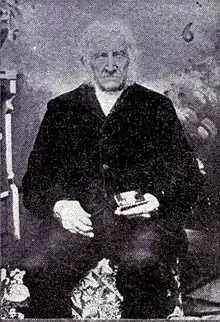 |
| John W. Loucks | Burned the Nash Creek Bridge to prevent the American advance through Dundas, fought at the Battle of Crysler's Farm as a Private in Captain Fraser's Provincial Dragoons and as an Ensign in Capt. Crysler's Company, 1st Dundas Regiment at the Battle of the Windmill. Promoted to Lieutenant and Captain in the militia in the 1840s-50s |  |
| Warner Casselman | Private in Captain Doran's Company, 2nd Dundas Regiment, at the Battle of the Windmill |  |
| William Errington | Private in Captain Chrysler's Company, 1st Dundas Regiment, wounded at the Battle of the Windmill |  |
| Allan McIntosh | Private in Captain Shaver's Company, 2nd Dundas Regiment at the Battle of the Windmill |  |
| Charles McIntosh | Private in Captain Doran's Company, 2nd Dundas Regiment at the Battle of the Windmill |  |
| David McIntosh | Sergeant in Captain Doran's Company, 2nd Dundas Regiment at the Battle of the Windmill, Ensign in the 2nd (Matilda) Battalion in 1847 | 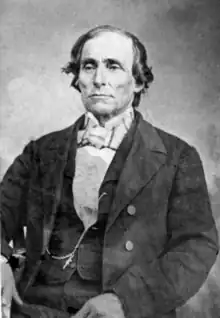 |
| John Adam Shaver | Sergeant in Capt. Crysler's Company, 1st Dundas Regiment at the Battle of the Windmill, Captain in the 4th (Winchester) Battalion |  |
| Giles Winfield Bogart | Private in the Grenville Militia at the Battle of the Windmill, Ensign in the 3rd Battalion, Dundas Militia in 1847, Captain of a company of the Dundas Militia in 1869 |  |
| John Pliny Crysler | Captain in the Dundas Militia during the Upper Canada Rebellion and Commanding Officer of the 4th (Winchester) Battalion, Dundas Militia 1859-1860s |  |
| John Van Allen | Private in Captain Robertson's Company, 2nd Dundas Regiment at Fort Wellington in November 1838 |  |
| Peter Droppo | Private in Captain Doran's Company, 2nd Dundas Regiment in 1839 |  |
| Pembroke G. Crysler | Lieutenant in the 1st (Williamsburg) Battalion, Dundas Militia in the 1840s-50s |  |
| David Rae | Private in the Glengarry Militia during the Upper Canada Rebellion and Lieutenant in the 4th (Winchester) Battalion, Dundas Militia in 1863 |  |
| Isaac Newton Rose | Lieutenant in the Dundas Militia at the Battle of the Windmill, Captain of the Dundas Infantry Company from 1862 to 1865, and commanded a battalion of the Dundas Militia in 1869 | 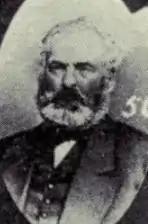 |
| James Holden | Captain of the 1st Williamsburg (Dundas) Rifles, 1857-1864 |  |
| William S. Van Allen | Private in the 1st Williamsburg (Dundas) Rifles, 1857-1861, Private in the Morrisburg Garrison Artillery 1862 |  |
| Alexander Farlinger | Dundas Militiaman who raised the Morrisburg Volunteer Rifle Company during the Trent Affair, in 1862 |  |
| Thomas Stafford Rubidge | Captain who raised the Morrisburg Garrison Artillery during the Trent Affair in 1862, and commanded it in the Fenian Raids in 1866, awarded the Canada General Service Medal |  |
| Joseph Sherbenaut | Corporal in the Morrisburg Garrison Artillery during the Fenian Raids of 1866, awarded the Canada General Service Medal | .png.webp) |
| Peter Bogart | Ensign in the 4th (Winchester) Battalion, Dundas Militia, 1863 |  |
| Robert Kyle | Ensign in the 4th (Winchester) Battalion, Dundas Militia, 1863 | 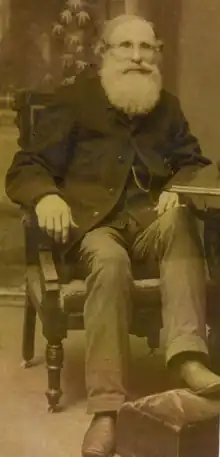 |
| Alexander Stallmire | Lieutenant in the 4th (Winchester) Battalion, Dundas Militia, 1863 |  |
| Henry W. Moad | Ensign in the 4th (Winchester) Battalion, Dundas Militia, 1863 |  |
| Almon Casselman | Gunner in the Morrisburg Garrison Artillery during the Fenian Raids of 1866, awarded the Canada General Service Medal | 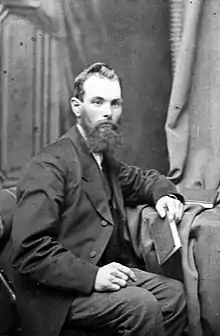 |
| John Henry McPhee | Gunner in the Morrisburg Garrison Artillery during the Fenian Raids of 1866, awarded the Canada General Service Medal |  |
| William Millar | Sergeant in the Iroquois Garrison Artillery during the Fenian Raids of 1866 and 1870, awarded the Canada General Service Medal |  |
| Theodore F. Chamberlain | Lieutenant in the Dundas Infantry Company during the Fenian Raids | 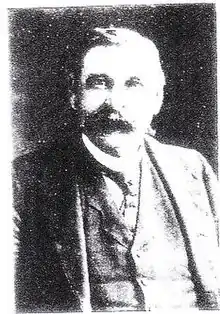 |
| Joseph Hyndman | Captain in the Dundas Militia during the Fenian Raids, commanded a battalion in 1869 |  |
Battle honours
In the list below, the battle honours that were earned by the Dundas Militia, and perpetuated by the Stormont, Dundas and Glengarry Highlanders are shown.
War of 1812
- Defence of Canada – 1812–1815
- Crysler's Farm
Rebellions of 1837-38
- Windmill Point
Fenian Raids
- Defence of Canada – 1862–1865
- Fenian Raids 1866-70
See also
References
- Carter, J.Smyth (1905). "The story of Dundas, being a history of the county of Dundas from 1784 to 1904". Internet Archive. pp. 228–251. Retrieved 10 February 2022.
 This article incorporates text from this source, which is in the public domain.
This article incorporates text from this source, which is in the public domain. - Mills, T.F. (2003). "Dundas Militia". Regiments.org. Archived from the original on 23 June 2004. Retrieved 1 June 2022.
- CROIL, James (1861). "Dundas: or, a Sketch of Canadian History". Google Books. Retrieved 10 February 2022.
- Irving, L.Homfray (1908). "Officers of the British Forces in Canada during the War of 1812-15" (PDF). Google Books. Retrieved 1 June 2022.
- Harkness, John Graham. "Stormont, Dundas and Glengarry : A history, 1784–1945". Internet Archives. Retrieved 10 February 2022.
- Boss C.D., Lt-Col. W. (1952). The Stormont, Dundas and Glengarry Highlanders 1783 - 1951. The Runge Press Limited. p. 43.
- Boss C.D., Lt-Col. W. (1952). The Stormont, Dundas and Glengarry Highlanders 1783 - 1951. The Runge Press Limited. p. 62.
- Boss C.D., Lt-Col. W. (1952). The Stormont, Dundas and Glengarry Highlanders 1783 - 1951. The Runge Press Limited. p. 63.
- Thompson, Joshua (1851). Militia list for Canada West. ISBN 9780665481932. Retrieved 8 March 2022 – via Archive.org.
 This article incorporates text from this source, which is in the public domain.
This article incorporates text from this source, which is in the public domain. - Canadian Parliament (1858). "Journals of the Legislative Council of the Province of Canada, 16th Edition". Google Books. Retrieved 12 February 2022.
- Canadian Parliament (1863). "Report on the State of the Militia of the Province, 1863". Google Books. Retrieved 12 February 2022.
- Desbarats, G. (1863). The Active or volunteer militia force list of Canada -30th April, 1863. ISBN 9780665919152. Retrieved 8 March 2022 – via Archive.org.
- Parliament of Canada (1858). "Journals of the Legislative Council of the Province of Canada". Google Books. Retrieved 8 March 2022.
- Patterson, W.J. (1995). Up the Glens : Stormont, Dundas and Glengarry Highlanders, 1783-1994. The Old Book Store Publishing.
- Boss C.D., Lt-Col. W. (1952). The Stormont, Dundas and Glengarry Highlanders 1783 - 1951. The Runge Press Limited. pp. 72–73.
- MacDonald, John Alexander. "Troublous Times in Canada: A History of the Fenian Raids of 1866 and 1870". Wikipedia. Retrieved 30 May 2022.
- Charlesworth, Hector Willoughby. "A Cyclopædia of Canadian Biography". Faded Page. Retrieved 13 February 2022.